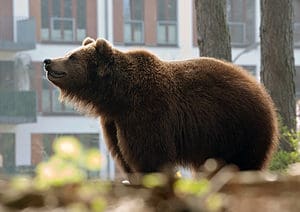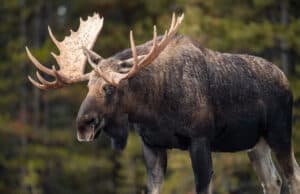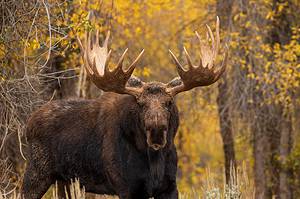If you’ve ever seen one in person, then you know that moose are some of the largest animals in North America. They’ve been known to shock people with their surprising size, and this is just when they reach the average height and weight. As a result, the largest moose ever caught in Alaska, which exceeds the typical measurements of a moose, definitely drew attention — enough so that we’re still talking about it a century later!
Intrigued? Keep reading below to learn not only about the moose in general but also about the largest moose ever caught in Alaska.
About Moose
Believe it or not, the moose is actually a species of deer. The only species in the genus Alces, moose belong to the family Cervidae, which includes all true deer. As you may have guessed, then, the moose is the largest and heaviest species of deer that is still alive today. Moose tend to be found in the northern hemisphere, such as in Canada and the northernmost United States, as well as in Russia and the surrounding areas. Here, they favor the forests in climates ranging from temperate to subarctic, showcasing this amazing species’ ability to adapt to different areas.
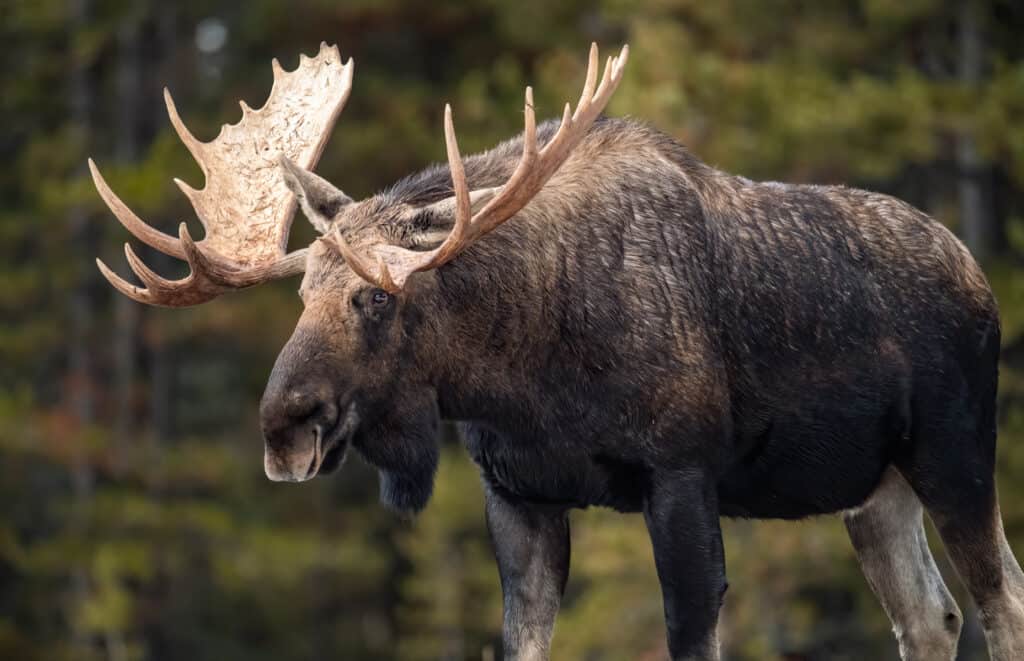
Moose are a species of deer belonging to the
Cervidaefamily.
©Harry Collins Photography/Shutterstock.com
Their large size is accomplished through an entirely herbivorous diet. Moose eat plants found both on land and in water. However, their size isn’t the only way they stray from typical deer species. Moose are also solitary animals. Other than calves, adult moose do not form herds or spend their time with any other moose. The main predators of the moose include wolves, bears, and orcas. Humans have also played a large role in the declining numbers of this interesting species. Like other species of cervids, moose are known for their large antlers that are used when competing for mates. They shed their antlers every winter and spend the spring growing an entirely new set. This new set can take up to five months to grow. Because they have antlers and not horns, moose’s antlers are covered in velvet that is eventually shed prior to mating season.
Moose Subspecies Sizes
There are four different subspecies of moose: the eastern moose, the western moose, the Alaska moose, and the Shiras moose. Although they are all the same species, these different types of moose can vary greatly in size. The Shiras moose is the smallest subspecies. The Alaska moose, however, is the largest.
The Shiras moose are found in British Colombia, Canada, and much of the northwestern United States. This includes states like Montana and Idaho. However, they can also be found as far south as Colorado. Even though they are the smallest subspecies of moose, the Shiras moose still sports an incredible height and weight. These moose weigh over 1,000 pounds and can grow to be over six feet tall at the shoulder. This means that their average height doesn’t even consider their head and impressive antlers!
The Alaska moose is found in its namesake state as well as the western Yukon. In fact, you’ll find later on that the largest moose in Alaska was actually recorded in the Yukon! Adult males of this subspecies can weigh almost double that of the Shiras moose at around 1,600 pounds. They also grow to be almost seven feet tall at their shoulders.
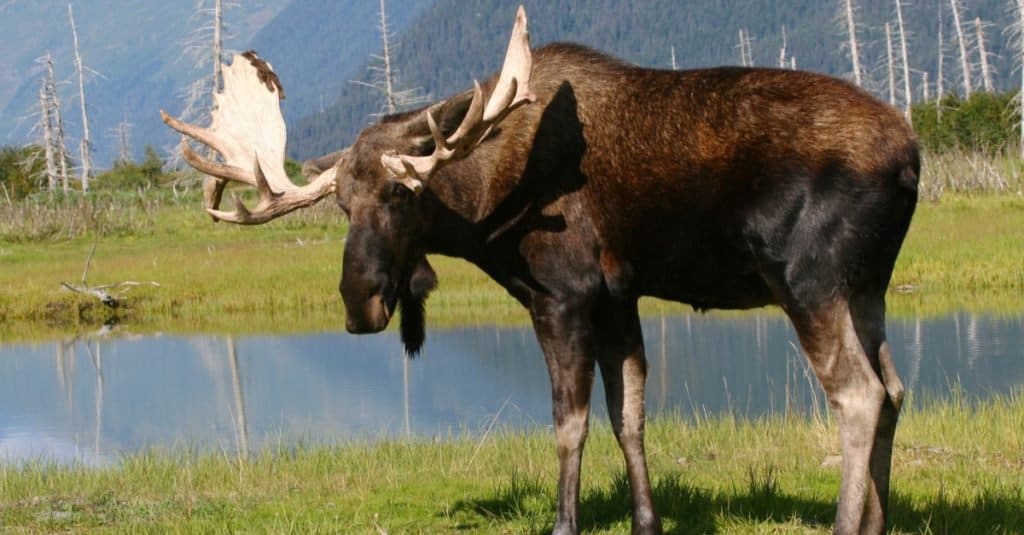
The Alaska moose is the largest subspecies of moose.
©Steve Bower/Shutterstock.com
The Largest Moose In Alaska
Now that you know a little more about the sizes of different subspecies of moose, we can learn about the largest moose ever caught in Alaska.
As the most noticeable species in the region, the largest moose in Alaska was none other than the Alaskan moose. While this subspecies is already the largest of the large, this particular individual holds the record for being not only the largest moose ever caught in Alaska but in the world.
This Guinness Book of World Records winning dates back to September 1897, when the largest moose was killed in the Alaskan Yukon. A male individual, this moose could easily be considered a giant, even compared to other moose. From the ground to its shoulder, the moose stood an amazing 7.6 feet high. When you consider its head and antlers, you get a moose that is easily over 8 feet tall! As for weight, the largest moose weighed in at 1808 pounds. That’s the same as four large metal dumpsters.
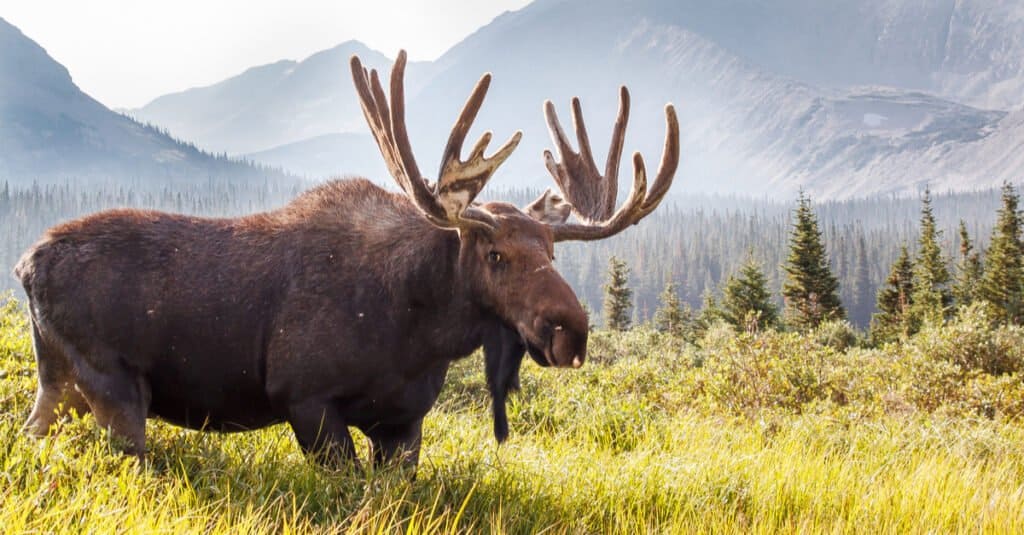
Having been shot and killed in 1897, pictures aren’t available of the largest moose ever caught in Alaska, but it was massive at 1,808 pounds.
©Michael Liggett/Shutterstock.com
Largest Moose Antlers on Record
As of right now, the largest moose antlers to ever be recorded measure over 6 feet and 3 inches across. They achieved the current record-holding score of 263-⅝ from the Boone and Crockett Club, an American non-profit dedicated to wildlife and conservation. This score, however, takes many different aspects of the antlers into account, not just width.
The widest moose antlers on record can be found on a different individual in 1998. These antlers measured about 7 inches wider than the other record-holding antlers. This makes them around 82 inches wide, or 6 feet and 10 inches. This is wider than most adult humans are tall!
Where Is the Alaskan Yukon Located on a Map?
While the Yukon is located in Canada, between Alaska and the Northwest Territories, the Alaskan Yukon is called the Yukon-Koyukuk Census Area, beginning in the state’s center and spanning east to the Canadian border. Fairbanks is one of the largest cities near this territory.
Alaska is located in the far upper northwest corner of North America. It is the northern and westernmost state. It is bordered by the Canadian provinces of British Columbia and the Yukon to the east, by the Chukchi and Beaufort Seas to the north, by the Bering Sea to the east, which border it shares with the Russian Federation of Chukotka, and the Pacific Ocean is to the south.
The photo featured at the top of this post is © David Osborn/Shutterstock.com
Thank you for reading! Have some feedback for us? Contact the AZ Animals editorial team.



